Sea urchin-like PdCuAu nanoclusters mediated photothermal enhanced Fenton catalysis for degradation of dye pollutants
Jianbo Zhang a, Kun Lei a,⁎, Ji Cheng b, Lingqing Luo b,⁎, Xiaojun Liu c, Jinghua Li【李景华】 a,b,c,⁎⁎
a College of Medical Technology and Engineering, The 1st Affiliated Hospital, Henan University of Science and Technology, Luoyang 471000, China
b Key Laboratory of Hainan Trauma and Disaster Rescue, The 1st Affiliated Hospital, College of Emergency and Trauma, Hainan Medical University, Haikou 570100, China
c NMPA Key Laboratory for Quality Evaluation of Medical Protective and Implant Devices, Zhengzhou 450003, China
Journal of Alloys and Compounds 958 (2023) 170494
https://doi.org/10.1016/j.jallcom.2023.170494
a b s t r a c t
This study focused on preparing sea urchin palladium-copper nanospines (PdCuAu NAs) using a one-step reduction method. PdCuAu NAs is a highly branched nanomaterial composed of nanospines, and its unique structure and trimetallic composition give it excellent Fenton catalytic activity and photothermal properties. The characterization of PdCuAu NAs was carried out using SEM, XPS, and UV-Vis techniques. Under near-infrared light, PdCuAu NAs were quickly heated to 50 ℃. Compared to traditional photocatalysts, PdCuAu NAs showed better Fenton catalytic activity in the degradation of organic dyes such as MB. Furthermore, it exhibited good photothermal stability and reusability after multiple thermal cycles and repeated use. Thus, the results showed that PdCuAu NAs had a good degradation effect on organic wastewater.
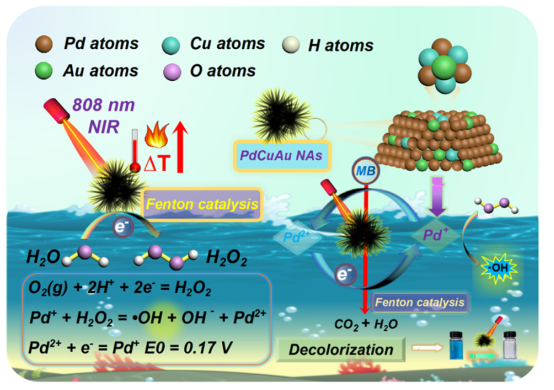
Scheme 1. Synthesis and catalytic degradation process of PdCuAu NAs.

Fig. 1. (a) SEM and (b) TEM images of PdCuAu NAs, (c) HRTEM images of PdCuAu NAs, (d) EDX mapping images of PdCuAu NAs, (e) EDS spectrum and (f) XRD patterns of PdCuAu NAs.

Fig. 2. (a) EDS spectrum and (b) XRD pattern of PdCuAu NAs, (c)-(f) XPS analysis of the PdCuAu NAs.
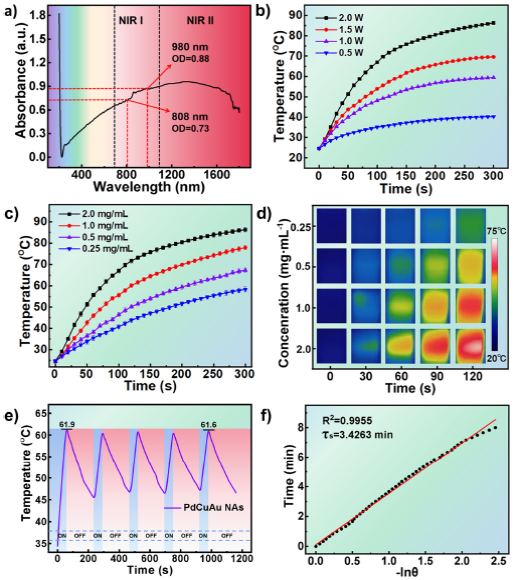
Fig. 3. Photothermal properties of PdCuAu NAs. (a) UV-Vis absorbance spectrum of PdCuAu NAs, (b) Temperature rise curves of PdCuAu NAs at different powers, (c) The concentration-dependent temperature rise of PdCuAu NAs under 808 nm near-infrared light (2.0 W∙cm−2, 2 min), (d) Optical image of heating of PdCuAu NAs at 808 nm near infrared light (2.0 W∙cm−2, 2 min), (e) Up-and-down cycle of PdCuAu NAs at 808 nm near infrared light (2.0 W∙cm−2), (f) The relationship between time and -lnθ was obtained by laser shutdown cooling period.
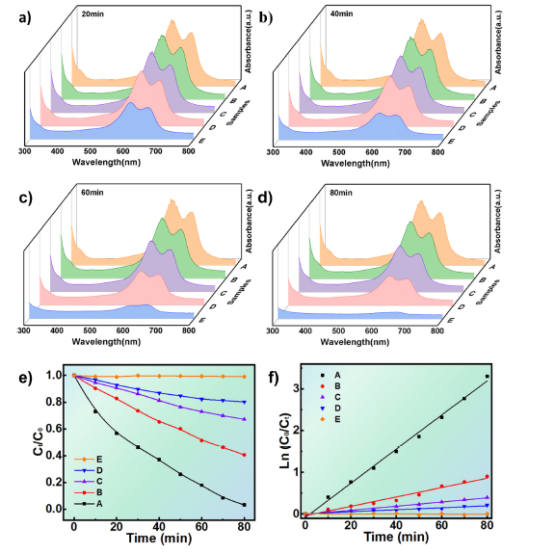
Fig. 4. Effect of different temperature on degradation of MB. (a)-(d) 20, 40, 60, 80 min (Concentration of PdCuAu NAs: 2.0 mg∙mL−1, A: PdCuAu NAs + H2O2 at 50 °C, B: PdCuAu NAs + H2O2 at 40 °C, C: PdCuAu NAs + H2O2 at 30 °C, D: H2O2, E: Control), Degradation efficiency (e) and reaction rate (f) of MB by PdCuAu NAs at different temperatures.
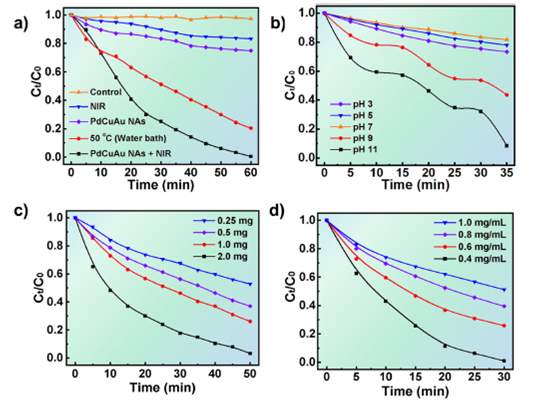
Fig. 5. (a) Degradation efficiency of MB under different conditions, (b) Effect of pH on degradation efficiency(concentration of dyestuff: 0.2 mg∙mL−1, PdCuAu NAs: 2.0 mg∙mL−1 and H2O2: 6%, temperature: 30 °C), (c) Effect of sample dosage on degradation efficiency (Concentration of dyes: 0.2 mg∙mL−1, H2O2: 6%, the NIR intensity is 2.0 W·cm−2), (d) Effect of initial concentration of dye on degradation efficiency (Concentration of PdCuAu NAs: 2.0 mg∙mL−1, H2O2: 6%, the NIR intensity is 2.0 W·cm−2).
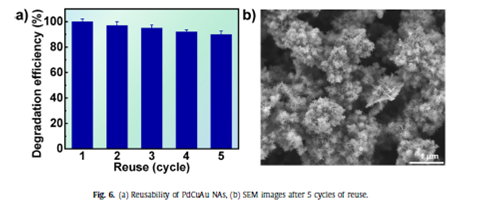
Fig. 6. (a) Reusability of PdCuAu NAs, (b) SEM images after 5 cycles of reuse.
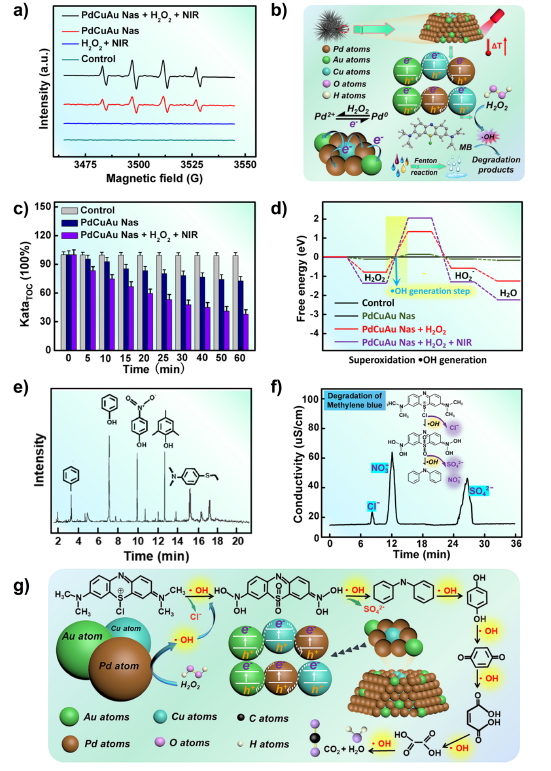
Fig. 7. PdCuAu NAs (a)EPR spectra, (b) Schematic mechanism, (c) DFT calculations of •OH generation, (d) TOC results, (e) GC-mass spectra, (f) determination of inorganic ions, and (g) Schematic diagram of MB degradation by PdCuAu NAs.
4. Conclusion
In summary, the sea urchin-like PdCuAu NAs nanocatalysts were prepared by one-step reduction method. The catalyst shows good photothermal synergistic Fenton-like catalytic performance, which can effectively remove MB dyestuff. Doping of metal atoms increase the surface stress and active sites of PdCuAu NAs crystals. At the same time, the presence of Au further promotes the absorption of near infrared light and accelerates the charge transfer. Through the above structural characteristics, PdCuAu NAs has excellent photothermal activity and Fenton catalytic performance. In addition, PdCuAu NAs nanocomposites can be recycled. The results show that the photothermal PdCuAu NAs nanoagent provides a new idea and effective technology for the treatment of dye wastewater.

